In the following graph, the X-axis will show:


1. substrate concentration
2. enzyme concentration
3. pH
4. enzyme concentration or substrate concentration


2. enzyme concentration
3. pH
4. enzyme concentration or substrate concentration
The rate of enzyme action decreases at higher temperature [after a certain value] because the increased heat
1. changes the pH of the system
2. alters the active site of the enzyme
3. neutralizes the acids and bases in the system
4. increases the concentration of the enzyme

To unlock all the explanations of 38 chapters you need to be enrolled in MasterClass Course.

To unlock all the explanations of 38 chapters you need to be enrolled in MasterClass Course.
The "lock and key hypothesis", given be Emil Fischer, attempts to explain the mechanism of:
1. denaturation of enzyme proteins
2. the formation of peptide binds
3. sharing of electrons
4. enzyme specificity
At about \(0^\circ C\) , most enzymes are
1. inactive
2. active
3. destroyed
4. replicated

To unlock all the explanations of 38 chapters you need to be enrolled in MasterClass Course.

To unlock all the explanations of 38 chapters you need to be enrolled in MasterClass Course.
If an active-site directed inhibitor is present in the medium, the curve that will represent the progress of the chemical reaction will be shown by the letter:
| 1. D | 2. C |
| 3. A | 4. B |
If an non active-site directed inhibitor is present in the medium, the curve that will represent the progress of the chemical reaction will be shown by the letter:
1. D
2. C
3. B
4. A

To unlock all the explanations of 38 chapters you need to be enrolled in MasterClass Course.

To unlock all the explanations of 38 chapters you need to be enrolled in MasterClass Course.
Which of the following will fit in the description of a competitive enzyme inhibitor?
1. a highly reactive compound.
2. a metal ion such as Hg2+ or Pb2+.
3. structurally similar to the substrate.
4. water insoluble.

To unlock all the explanations of 38 chapters you need to be enrolled in MasterClass Course.

To unlock all the explanations of 38 chapters you need to be enrolled in MasterClass Course.
A non-competitive inhibitor of an enzyme catalyzed reaction
1. binds to the Michaelis complex (ES).
2. increases Vmax.
3. is without effect at saturating substrate concentrations.
4. can actually increase reaction velocity in rare cases.
The measurement of which of the following would be indicator of the degree of inhibition by a competitive enzyme inhibitor?
1. Vmax
2. The y-intercept on a Limeweaver-Burke Plot
3. Km
4. ¼ Vmax

To unlock all the explanations of 38 chapters you need to be enrolled in MasterClass Course.

To unlock all the explanations of 38 chapters you need to be enrolled in MasterClass Course.
An allosteric inhibitor of an enzyme usually
1. binds to the active site.
2. participates in feedback regulation.
3. denatures the enzyme.
4. causes the enzyme to work faster.








